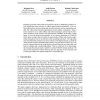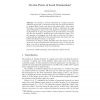87
Voted
NIPS
2007
15 years 2 months ago
2007
We propose an active learning algorithm that learns a continuous valuation model from discrete preferences. The algorithm automatically decides what items are best presented to an...
123
Voted
NIPS
2007
15 years 2 months ago
2007
We propose a method for reconstruction of human brain states directly from functional neuroimaging data. The method extends the traditional multivariate regression analysis of dis...
90
Voted
NIPS
2007
15 years 2 months ago
2007
We investigate a new, convex relaxation of an expectation-maximization (EM) variant that approximates a standard objective while eliminating local minima. First, a cautionary resu...
NIPS
2007
15 years 2 months ago
2007
We present a theoretical study on the discriminative clustering framework, recently proposed for simultaneous subspace selection via linear discriminant analysis (LDA) and cluster...
78
Voted
NIPS
2007
15 years 2 months ago
2007
We extend position and phase-shift tuning, concepts already well established in the disparity energy neuron literature, to motion energy neurons. We show that Reichardt-like detec...
111
Voted
NIPS
2007
15 years 2 months ago
2007
Planning in partially observable environments remains a challenging problem, despite significant recent advances in offline approximation techniques. A few online methods have a...
111
Voted
NIPS
2007
15 years 2 months ago
2007
A non–linear dynamic system is called contracting if initial conditions are forgotten exponentially fast, so that all trajectories converge to a single trajectory. We use contra...
95
Voted
SIROCCO
2008
15 years 2 months ago
2008
In this paper we examine the diffusion of competing rumors in social networks. Two players select a disjoint subset of nodes as initiators of the rumor propagation, seeking to maxi...
104
Voted
SIROCCO
2008
15 years 2 months ago
2008
We consider a network represented by a simple connected undirected graph with N anonymous nodes that have local orientations, i.e. incident edges of each vertex have locally-unique...
109
Voted
SIROCCO
2008
15 years 2 months ago
2008
In this paper, we consider the clustering of resources on large scale platforms. More precisely, we target parallel applications consisting of independant tasks, where each task is...


